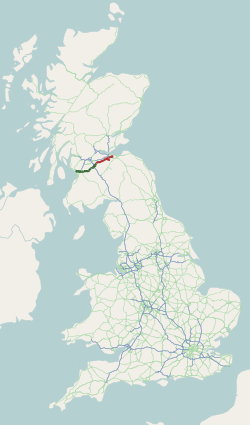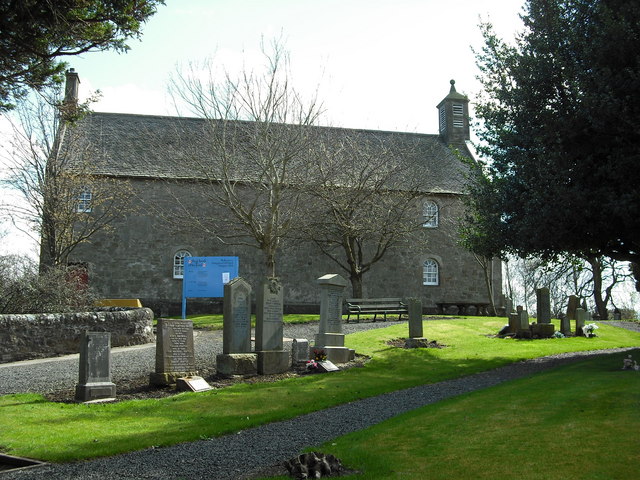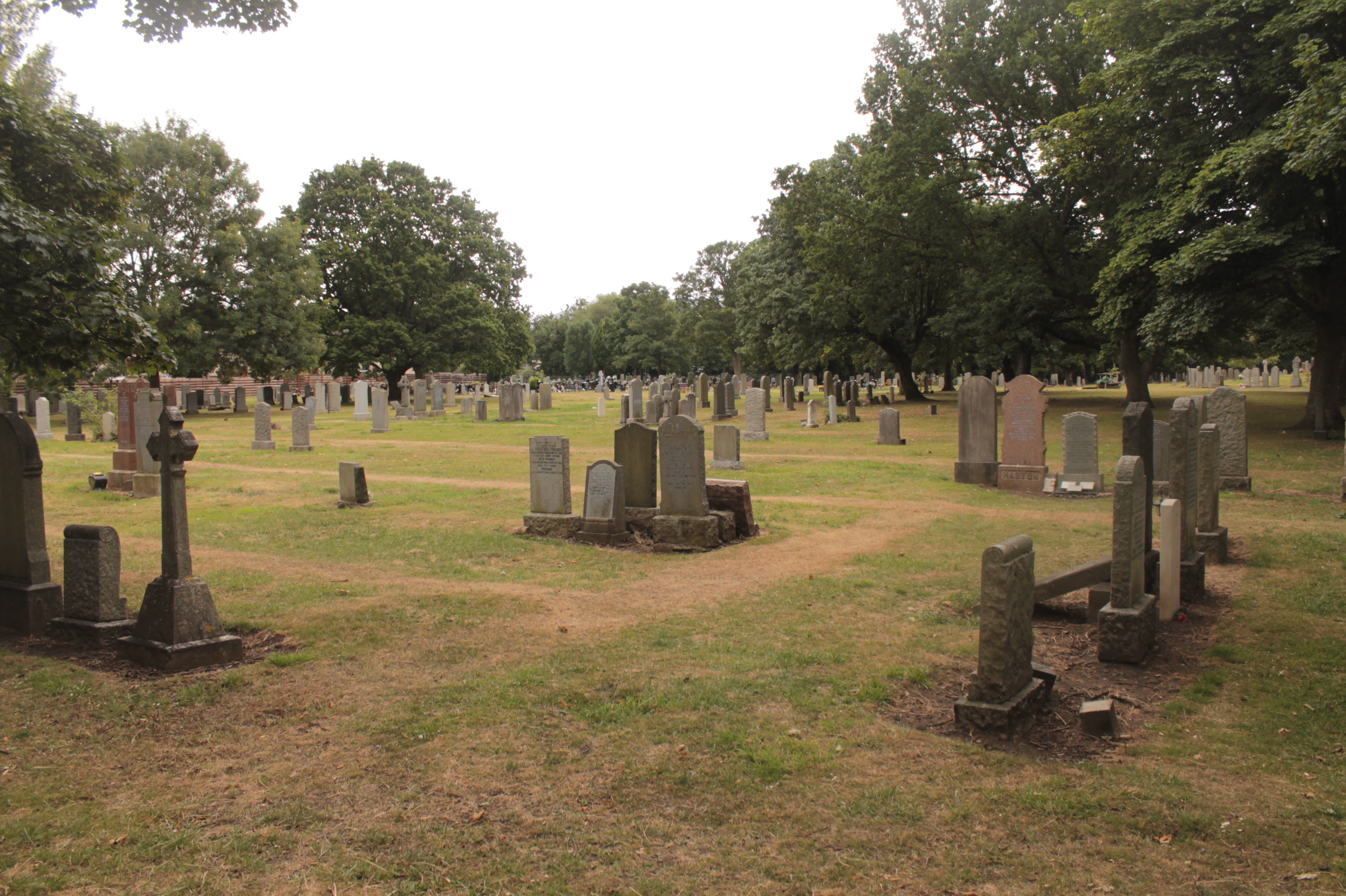|
A71 Road (Scotland)
The A71 is a major road in Scotland linking Edinburgh with Lanarkshire and Ayrshire. It adjoins the Livingston Bypass A899. It runs south west from Edinburgh for approximately 70 miles, through Saughton, Wilkieston and south of Livingston, Whitburn and Wishaw, then by way of Overtown, Garrion Bridge, Stonehouse, Strathaven, Darvel, Newmilns, Galston, Hurlford and Kilmarnock to Irvine on the North Ayrshire coast. Formerly a trunk route from the east to the west coast of Scotland it has since been downgraded to a mix of primary and secondary routes. From Edinburgh to Darvel, it is now a secondary route, in a poor state of repair in some places. But, from Darvel to Irvine, it has retained its primary route status. Route Edinburgh to Newmains The A71 almost parallels the M8 between the A720 (Edinburgh City Bypass) and the junction with the A73 at Newmains. It passes through the village of Wilkieston and onto the Mid Calder bypass, which leads the route to the south ... [...More Info...] [...Related Items...] OR: [Wikipedia] [Google] [Baidu] |
A71 Road Map
{{Letter-NumberCombDisambig ...
A71 or A-71 may refer to: * A71 road in Afghanistan * A71 motorway (France) * A71 road (Scotland) * Benoni Defense, in the Encyclopaedia of Chess Openings * Bundesautobahn 71, a German motorway also called A 71 * Mitchell Highway, a road in Queensland * Samsung Galaxy A71, smartphone released in 2019 * "A71", a song by New Jersey band Lorna Shore Lorna Shore is an American deathcore band formed in New Jersey in 2009. The group currently consists of lead guitarist Adam De Micco, drummer Austin Archey, rhythm guitarist Andrew O'Connor, vocalist Will Ramos, and bassist Michael Yager. The ba ... [...More Info...] [...Related Items...] OR: [Wikipedia] [Google] [Baidu] |
Morningside, North Lanarkshire
Morningside is a small village in North Lanarkshire, Scotland. It is located around south of Newmains, and east of Wishaw. Morningside's population (as of 2016) is 1,090 people. It is a former coal mining village, and formerly had two railway stations. Today, Morningside mainly consists of a modern housing estate with more older houses along the main road. Battle of Morranside According to local legend, a large battle occurred on the site of Morningside during the English invasion in 1385. The English sent a force of around 1,000 men to raid Lanarkshire, the Scots met them at "''Morranside"'' in early autumn being commanded by the leaders of Clan Muir and Clan Douglas Clan Douglas is an ancient clan or noble house from the Scottish Lowlands. Taking their name from Douglas in Lanarkshire, their leaders gained vast territories throughout the Borders, Angus, Lothian, Moray, and also in France and Sweden. The f .... The battle ended in a Scottish victory with the English b ... [...More Info...] [...Related Items...] OR: [Wikipedia] [Google] [Baidu] |
Livingston, Scotland
Livingston ( sco, Leivinstoun, gd, Baile Dhunlèibhe) is the largest town in West Lothian, Scotland. Designated in 1962, it is the fourth post-war new town to be built in Scotland. Taking its name from a village of the same name incorporated into the new town, it was originally developed in the then-counties of Midlothian and West Lothian along the banks of the River Almond. It is situated approximately fifteen miles (25 km) west of Edinburgh and thirty miles (50 km) east of Glasgow, and is close to the towns of Broxburn to the north-east and Bathgate to the north-west. The town was built around a collection of small villages, Livingston Village, Bellsquarry, and Livingston Station (now part of Deans). The town has a number of residential areas. These include Craigshill, Howden, Ladywell, Knightsridge, Deans, Dedridge, Murieston, Almondvale, Eliburn, Kirkton, and Adambrae. There are several large industrial estates in Livingston, including Houston industrial e ... [...More Info...] [...Related Items...] OR: [Wikipedia] [Google] [Baidu] |
Wilkieston
Wilkieston is a small village in West Lothian, Scotland. It is located on the A71 road, north of Kirknewton, south-west of Ratho and east of Livingston. To the north-west of the village is Bonnington House, a 19th-century country house. To the north-east of the village are the remains of Hatton House, medieval home of the Lauder family, which was demolished in 1955. Linburn Park was a country house and estate in Wilkeston, located to the south of the village that was demolished in 1955. The estate is now home to the Linburn Centre, which is run by charity Scottish War Blinded. The centre provides assistance to adults who have been members of the armed forces and now have a visual impairment. Military Museum Scotland is a military history museum in Wilkieston that covers Scottish military history from the First World War World War I (28 July 1914 11 November 1918), often abbreviated as WWI, was one of the deadliest global conflicts in history. Belligerents in ... [...More Info...] [...Related Items...] OR: [Wikipedia] [Google] [Baidu] |
Saughton
Saughton () ( sco, Sauchtoun) ( gd, Baile nan Seileach) is a suburb of the west of Edinburgh, Scotland, bordering Broomhouse, Stenhouse, Longstone and Carrick Knowe. In Lowland Scots, a "sauch" is a willow. The Water of Leith flows by here. It is best known for its prison, known officially as "HM Prison Edinburgh", but colloquially as "Saughton Prison", which lies to the south of the district. The Calder Road, one of the main city arteries, runs through it. More recently Saughton Park has become home to an acclaimed outdoor concrete skatepark Actually situated in the Broomhouse area and fronting on Broomhouse Drive, Saughton House is a large Government office, said to have been built in the 1950s, which houses the Scottish Government, Scottish Courts Service and a number of other Government offices. Transport Tram Saughton tram stop is adjacently south of the main Glasgow to Edinburgh railway line, close to the junction of Broomhouse Drive and Saughton Road Nort ... [...More Info...] [...Related Items...] OR: [Wikipedia] [Google] [Baidu] |
Ayrshire
Ayrshire ( gd, Siorrachd Inbhir Àir, ) is a historic county and registration county in south-west Scotland, located on the shores of the Firth of Clyde. Its principal towns include Ayr, Kilmarnock and Irvine and it borders the counties of Renfrewshire and Lanarkshire to the north-east, Dumfriesshire to the south-east, and Kirkcudbrightshire and Wigtownshire to the south. Like many other counties of Scotland it currently has no administrative function, instead being sub-divided into the council areas of North Ayrshire, South Ayrshire and East Ayrshire. It has a population of approximately 366,800. The electoral and valuation area named Ayrshire covers the three council areas of South Ayrshire, East Ayrshire and North Ayrshire, therefore including the Isle of Arran, Great Cumbrae and Little Cumbrae. These three islands are part of the historic County of Bute and are sometimes included when the term ''Ayrshire'' is applied to the region. The same area is known as ''Ayrshire a ... [...More Info...] [...Related Items...] OR: [Wikipedia] [Google] [Baidu] |
Lanarkshire
Lanarkshire, also called the County of Lanark ( gd, Siorrachd Lannraig; sco, Lanrikshire), is a historic county, lieutenancy area and registration county in the central Lowlands of Scotland. Lanarkshire is the most populous county in Scotland, as it contains most of Glasgow and the surrounding conurbation. In earlier times it had considerably greater boundaries, including neighbouring Renfrewshire until 1402. Lanarkshire is bounded to the north by the counties of Stirlingshire and Dunbartonshire (this boundary is split into two sections owing to Dunbartonshire's Cumbernauld exclave), to the northeast by West Lothian and Mid Lothian, to the east by Peeblesshire, to the south by Dumfriesshire, and to the west by Ayrshire and Renfrewshire. Administrative history Lanarkshire was historically divided between two administrative areas. In the mid-18th century it was divided again into three wards: the upper, middle and lower wards with their administrative centres at Lanark, Hamil ... [...More Info...] [...Related Items...] OR: [Wikipedia] [Google] [Baidu] |
Scotland
Scotland (, ) is a country that is part of the United Kingdom. Covering the northern third of the island of Great Britain, mainland Scotland has a border with England to the southeast and is otherwise surrounded by the Atlantic Ocean to the north and west, the North Sea to the northeast and east, and the Irish Sea to the south. It also contains more than 790 islands, principally in the archipelagos of the Hebrides and the Northern Isles. Most of the population, including the capital Edinburgh, is concentrated in the Central Belt—the plain between the Scottish Highlands and the Southern Uplands—in the Scottish Lowlands. Scotland is divided into 32 administrative subdivisions or local authorities, known as council areas. Glasgow City is the largest council area in terms of population, with Highland being the largest in terms of area. Limited self-governing power, covering matters such as education, social services and roads and transportation, is devolved from the Scott ... [...More Info...] [...Related Items...] OR: [Wikipedia] [Google] [Baidu] |
Road
A road is a linear way for the conveyance of traffic that mostly has an improved surface for use by vehicles (motorized and non-motorized) and pedestrians. Unlike streets, the main function of roads is transportation. There are many types of roads, including parkways, avenues, controlled-access highways (freeways, motorways, and expressways), tollways, interstates, highways, thoroughfares, and local roads. The primary features of roads include lanes, sidewalks (pavement), roadways (carriageways), medians, shoulders, verges, bike paths (cycle paths), and shared-use paths. Definitions Historically many roads were simply recognizable routes without any formal construction or some maintenance. The Organization for Economic Co-operation and Development (OECD) defines a road as "a line of communication (travelled way) using a stabilized base other than rails or air strips open to public traffic, primarily for the use of road motor vehicles running on their own wheels", whic ... [...More Info...] [...Related Items...] OR: [Wikipedia] [Google] [Baidu] |
Crosshouse
Crosshouse is a village in East Ayrshire about west of Kilmarnock. It grew around the cross-roads of the main Kilmarnock to Irvine road, once classified as the A71 but now reduced in status to the B7081, with a secondary road (the B751) running from Kilmaurs south to Gatehead and beyond towards Prestwick. The Carmel Water, a tributary of the River Irvine, flows through the centre of the village. It had an estimated population of in Andrew Fisher, who was the fifth Prime Minister of Australia, was born in the village and a plaque commemorating him is located at the road junction to Knockentiber. Health The village is the location of a major hospital, Crosshouse Hospital, which was built to replace the Kilmarnock Infirmary. Transport Crosshouse is served by the Stagecoach Group, running through from Kilmarnock to Irvine and Ardrossan Ardrossan (; ) is a town on the North Ayrshire coast in southwestern Scotland. The town has a population of 10,670 and forms part of a conurba ... [...More Info...] [...Related Items...] OR: [Wikipedia] [Google] [Baidu] |
West Calder
West Calder ( sco, Wast Cauder, gd, Caladar an Iar) is a village in the council area of West Lothian, Scotland, located four miles west of Livingston, West Lothian, Livingston. Historically it is within the County of Midlothian. The village was an important centre in the oil shale industry in the 19th and 20th Centuries. West Calder has its own West Calder railway station, railway station. The surrounding villages that take West Calder's name in their address - Polbeth, Addiewell, Loganlea, Harburn, West Lothian, Harburn and Westwood - outline the area that this village encompasses, and they all have played an important part in the history of the village as well as West Lothian. The village is a 10-minute drive from Livingston, which is host to two large shopping centres. The village lies along the ridge above the Calder burn. History Early evidence of settlement in the area of West Calder is indicated by the presence of Castle Greg, an Ancient Rome, Roman fortlet to the sou ... [...More Info...] [...Related Items...] OR: [Wikipedia] [Google] [Baidu] |





.jpg)


